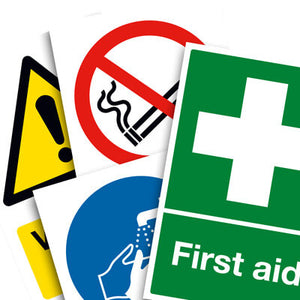While we are proud of our large range of health and safety signs, we understand that choosing the correct safety sign may be a bit daunting for our customers at first. To help you choose your signs as quickly and confidently as possible we have compiled a quick guide to help you in this process.
Our 5 Step process to help you select the right sign for your needs
Decide what message you are trying to communicate. Your safety message will have the effect of helping prevent potential injuries and accidents. Ensure that the message is clear and informative. For example;
- Do you need to highlight a potential hazard?
- Do you need to call attention to a safe method of work or the quickest route to an exit in case of fire or emergency?
- Do you need to discourage risk taking behaviour?
- Do you need to enforce and maintain quality standards?
- Would a multi-message sign be more appropriate than a sign with a single message?
Determine where the sign should go. A sign needs to be clearly visible, at a suitable viewing height and its placement needs to be appropriate to the message you are trying to convey. Some questions to ask;
- Does it need to be placed on a door, wall, post, fence or ceiling?
- Does it need to be applied onto a vehicle, machine or equipment?
- Does your sign need to be part of a series of signs that will form a route to an exit or an assembly area?
- Does it need to highlight a hidden area or resource from a viewer's normal view or line of sight? For example; an exit, extinguisher or AED at the end of a hall may need a suspending sign or PanoSign.
Choose an appropriate design and sign type. The sign should communicate its message as quickly and accurately as possible, ideally with a symbol relevant to the message. Symbols are particularly important if your employees speak more than one language. Other considerations when deciding on safety sign design;
Choose an appropriate size. The size will be dictated by viewing distance, so think about how far away the sign will need to be read. Other considerations when deciding on size;
- Does the area have good lighting?
- Will the sign fit in the proposed area or location?
Consider how and where the sign will be fixed or installed. This will determine the choice of the most appropriate material for the sign. For example;
- Will the sign be fixed to smooth tile, rough wall, curved equipment or railing?
- Is there potential of abrasive or rough contact to the sign?
- Is the sign needed for a temporary purpose or for long term use?
Additional information about products and legislation can be found on our Knowledge Centre.

